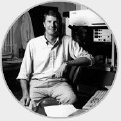MICCAI
2005
8th International Conference on Medical Image
Computing and Computer Assisted Intervention
Keynote Speakers
Scott
Fraser: "Imaging the developmental mechanics of the vertebrate embryo",
Friday Oct. 28th, 8.30-9:30

|
Professor
Scott Fraser, Director of the Biological Imaging Center
Division of Biology and Option of Bioengineering
California Institute of Technology Pasadena
CA 91125
sefraser(at)caltech.edu
http://biology.caltech.edu/Members/Fraser
http://quad.bic.caltech.edu/~fraserlab/index_content.html |
Abstract: The explosion of progress
in the elds of cell biology, biochemistry, and molecular biology
has offered unprecedented knowledge of the components involved
embryonic development. The dramatic progress of these reductionistic
approaches poses the challenge of integrating this knowledge into an
understanding of developmental mechanics that pattern and construct the
embryo. The classic publications in the field of experimental
embryology illustrate the power of describing cell behavior (cf.
lineages, movements) and perturbing the embryo to test hypotheses of
the underlying mechanisms. Advanced imaging techniques offer an
important stepping-stone between these disparate approaches, permitting
questions about cellular and molecular events to be posed in the most
relevant setting of the intact embryo.
Both confocal laser scanning
microscopy (CLSM) and two-photon laser scanning microscopy (TPLSM)
permit cells to be followed as they migrate in the intact embryo. In
vivo imaging of multiple labels should otffer the ability to test
proposed mechanisms by following different GFP-color variants on
multiple molecular species in the same cell. However, there are two
major stumbling blocks. First, image acquisition by laser-scanning
confocal microscopy is often too slow to capture individual image
planes with su cient rapidity. Second, it is dificult to capture 4-D
data at suficient temporal resolution especially if there is any
motion. When the studied motion is periodic, such as for a beating
heart, a way to circumvent this problem is studied motion is periodic,
such as for a beating heart, a way to circumvent this problem is to
acquire, successively, sets of 2D+time data at increasing depths and
later rearrange them to recover a 3D+time sequence. Recently we have
utilized a newly-developed fast acquisition confocal microscope (Zeiss
LSM 5 LIVE) to acquire very rapid, high-resolution 2D optical sections
of uorescently labeled cells in the developing zebrafish heart
and have established image registration algorithms allowing for the
registration of periodic movements. This method has allowed us to
create 4-dimensional working models of the heart and analyze mechanical
forces related to wall and valve motions from different stages of heart
development. This approach is generalizable to many different setting
in developmental biology and neurobiology.
In systems in which light-based imaging is problematic, we are
employing microscopic MRI. In MRI, radio frequency energy is used to
excite the protons of the water, which generates no toxic by-products.
Spatial resolution is created by imposing gradient magnetic fields on
the specimen, thereby making it possible to encode the signals from
individual volume elements (voxels) by their resonant frequency and
phase. By increasing the magnitudes of the static and gradient magnetic
fields, and by improving the electronics, it has become possible to
increase the resolution of MRI from the 1mm voxels of a clinical
instrument to 10µm. This approach has the promise of making
imaging analyses possible in the systems with limited access to the
embryos (e.g. mouse) or in which light scattering renders deep
structures invisible (e.g. frog).
Art
Toga: "Mapping the Structure and
Function of the Brain: Where we are and we want to be", Saturday Oct.
29th, 11.00-12.00

|
Professor Arthur W.
Toga
Laboratory
of Neuro Imaging
Department
of Neurology, UCLA School of Medicine
710
Westwood Plaza, Rm 4-238 , Los Angeles, CA 90095-1769
toga(at)loni.ucla.edu
http://www.loni.ucla.edu/
|
Professor Arthur Toga
is the director of LONI ((Laboratory of Neuro Imaging), one of the
country's foremost neurological research centers. LONI works towards
uncovering new knowledge that will lead to better health for everyone
by conducting research and building population-based and
disease-specific digital brain atlases, helping in the training of
research investigators; and fostering communication of medical
information.
Abstract: The ability to
statistically and visually compare and contrast brain image data from
multiple subjects is essential to understanding normal variability and
differentiating normal from diseased populations. This talk describes
some of these approaches and their application in basic and clinical
neuroscience. There are numerous probabilistic atlases that describe
specific subpopulations, measure their variability and characterize the
structural differences between them. Utilizing data from structural
MRI, we have built atlases with defined coordinate systems creating a
framework for mapping data from functional, histological and other
studies of the same population in several species. This talk describes
the basic approach and some of the constructs that enable the
calculation of probabilistic atlases and examples of their results from
several different normal and diseased populations. The talk will also
illustrate some approaches useful in understanding multidimensional
data and the relationships between them over time. Finally, there will
be challenges identified for future mapping and modeling between
modalities, time, subjects and species.
Research: I am interested in the
development of new algorithms and the computer science aspects
important to neuroimaging. New visualization techniques and statistical
measurement are employed in the study of morphometric variability in
humans, subhuman primates and rodents. My laboratory (Laboratory of
Neuro Imaging) has been working on the creation of three dimensional
digital neuroanatomic and functional neuroanatomic atlases for
stereotactic localization and multisubject comparison. Specific
programs include the development of local deformation techniques to
equate brain data sets from different modalities and different subjects
and the development of electronic data bases for the archival,
interaction and distribution of brain data.
Web-administration: Martin Styner (styner at miccai2005.org)


